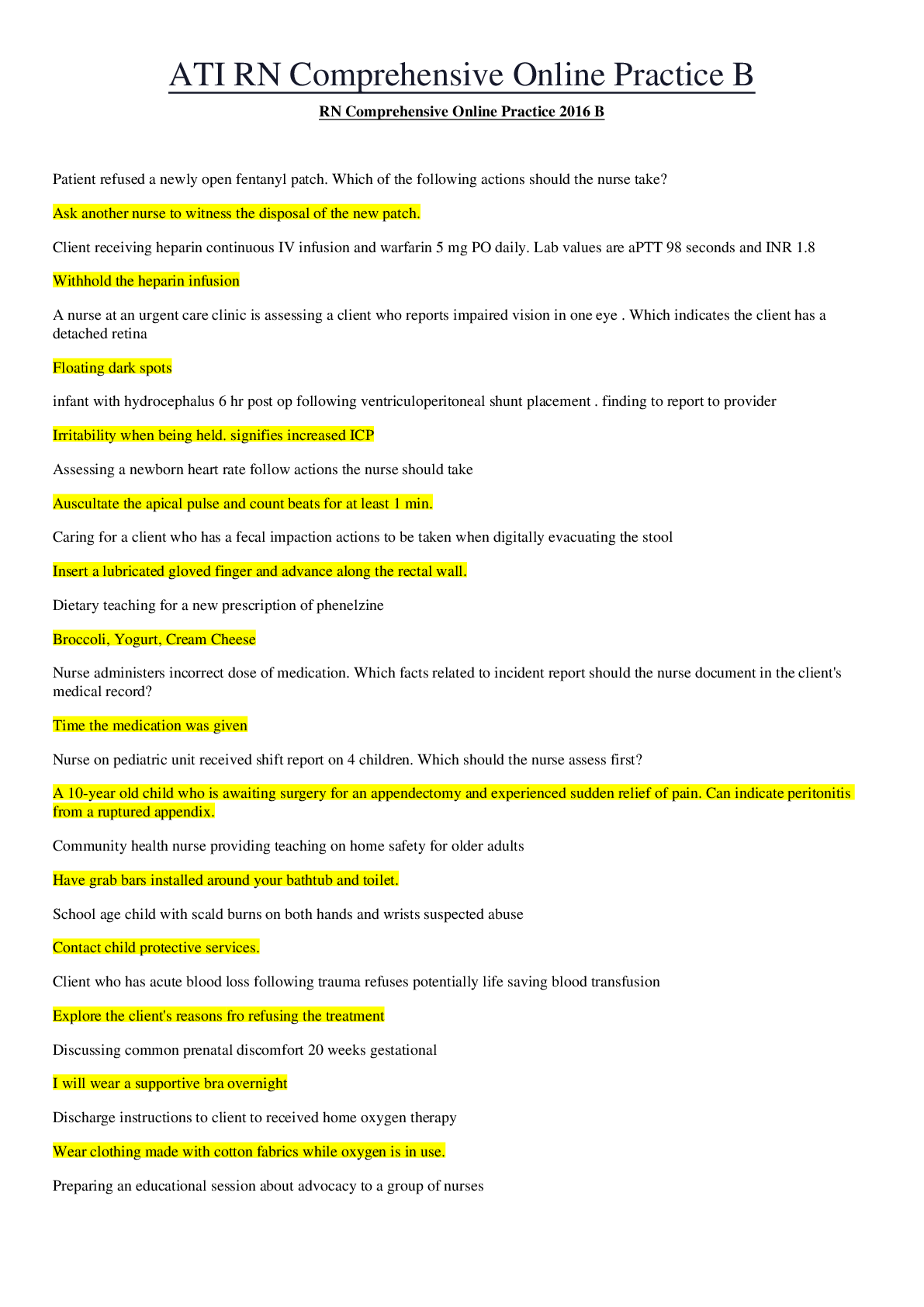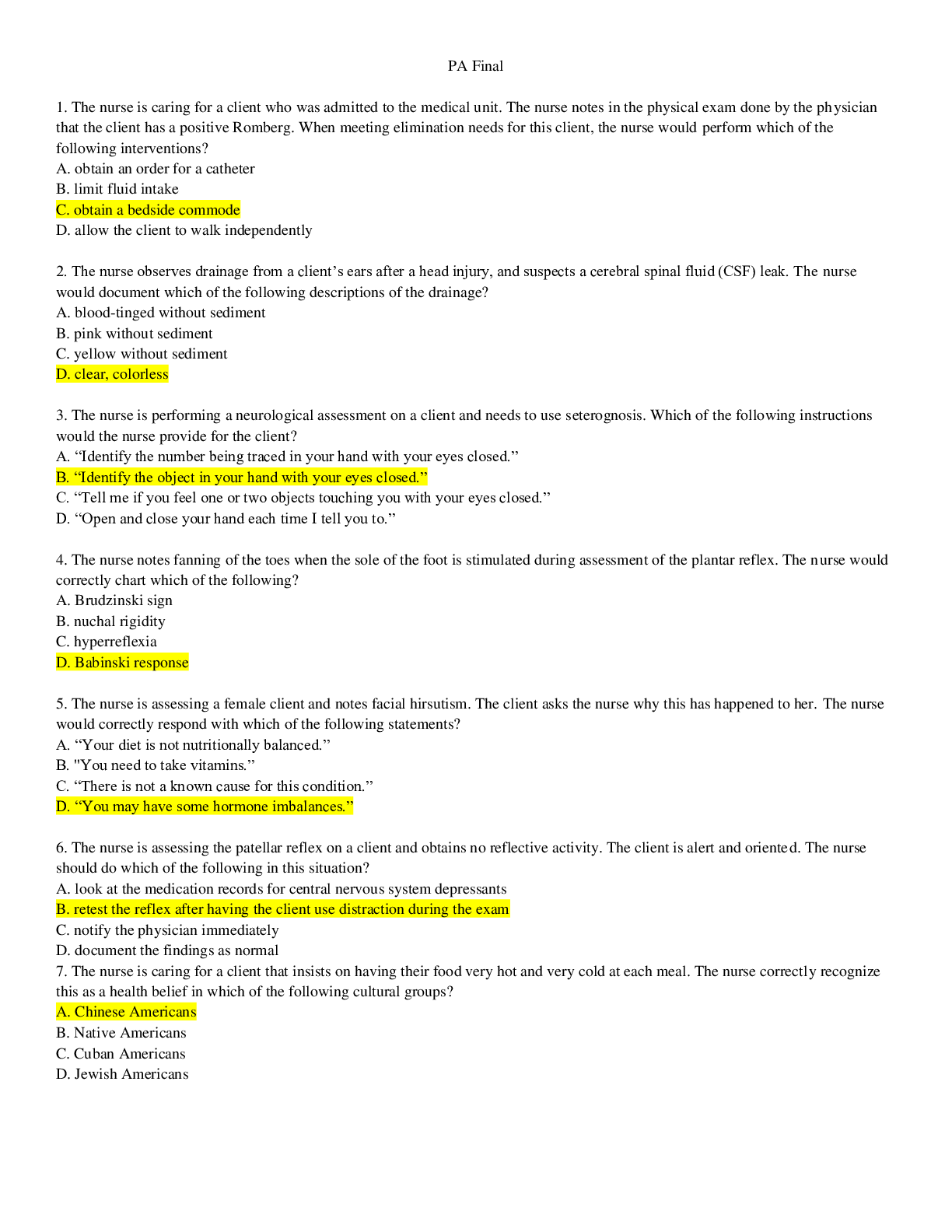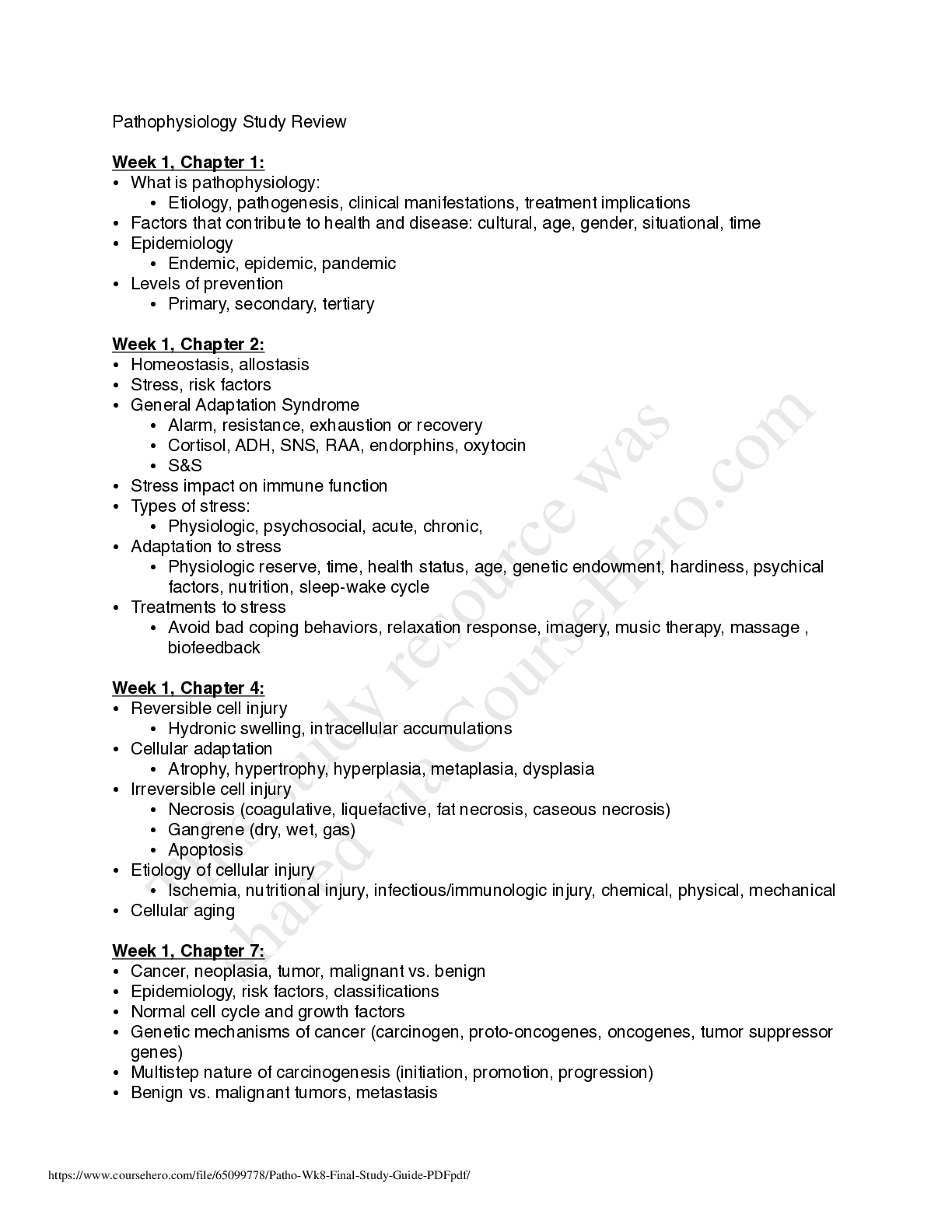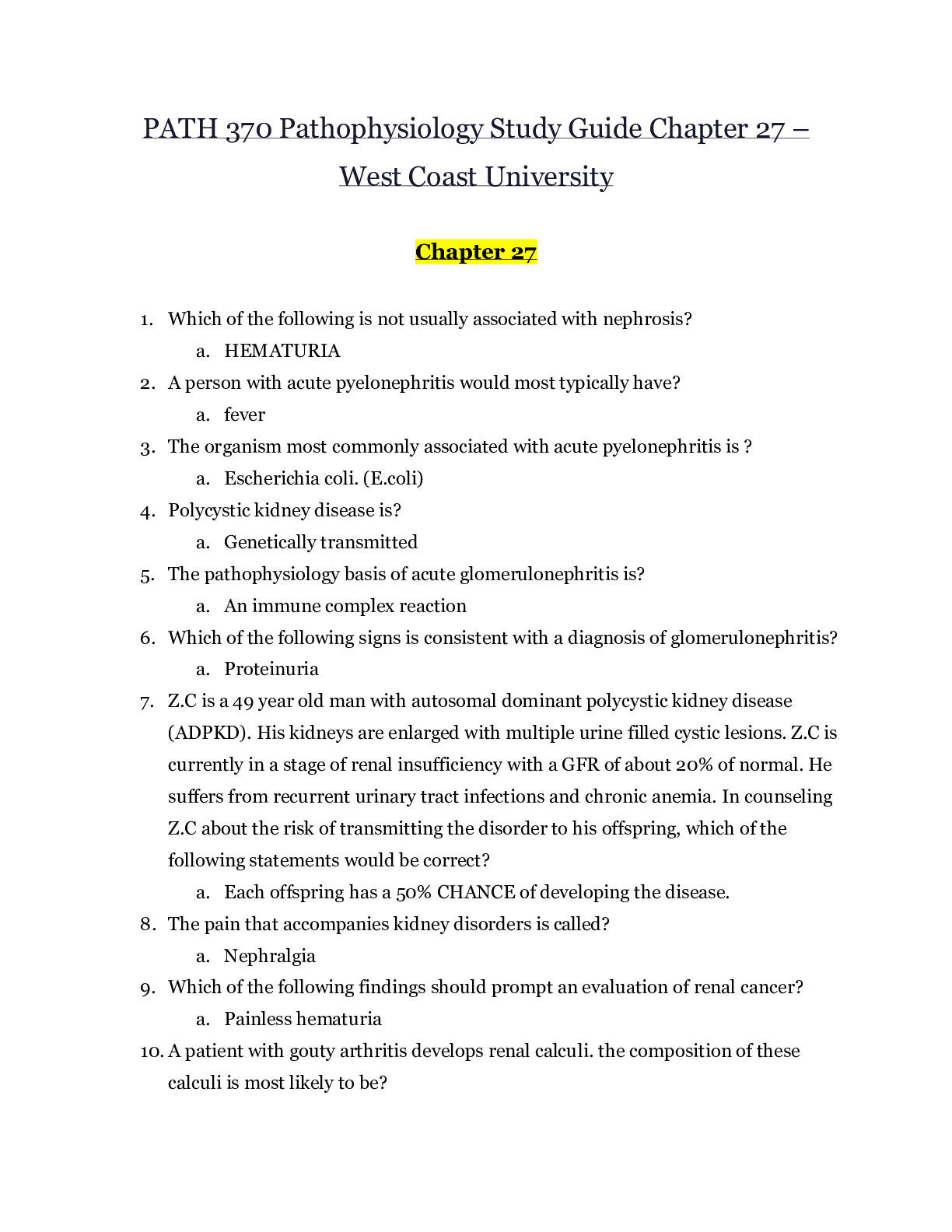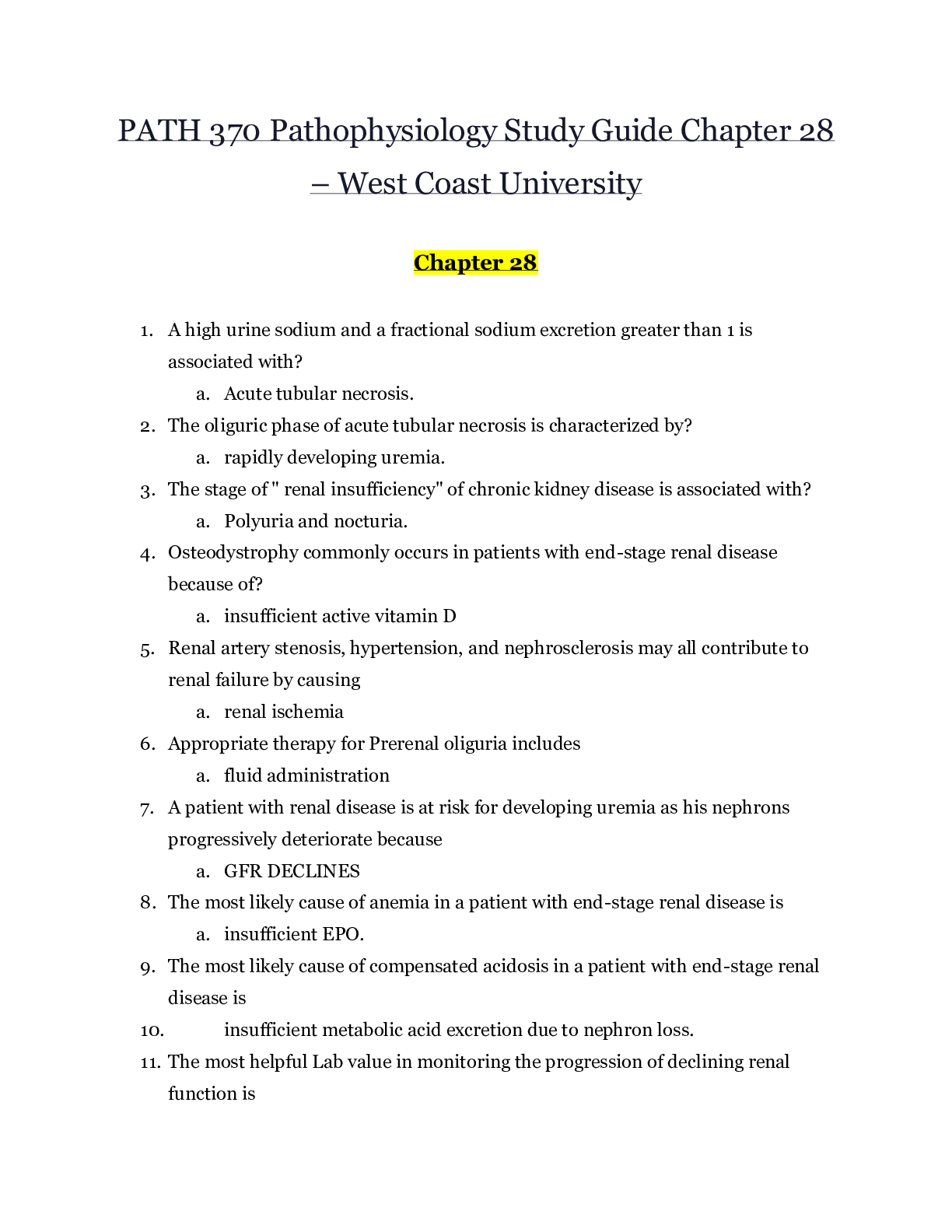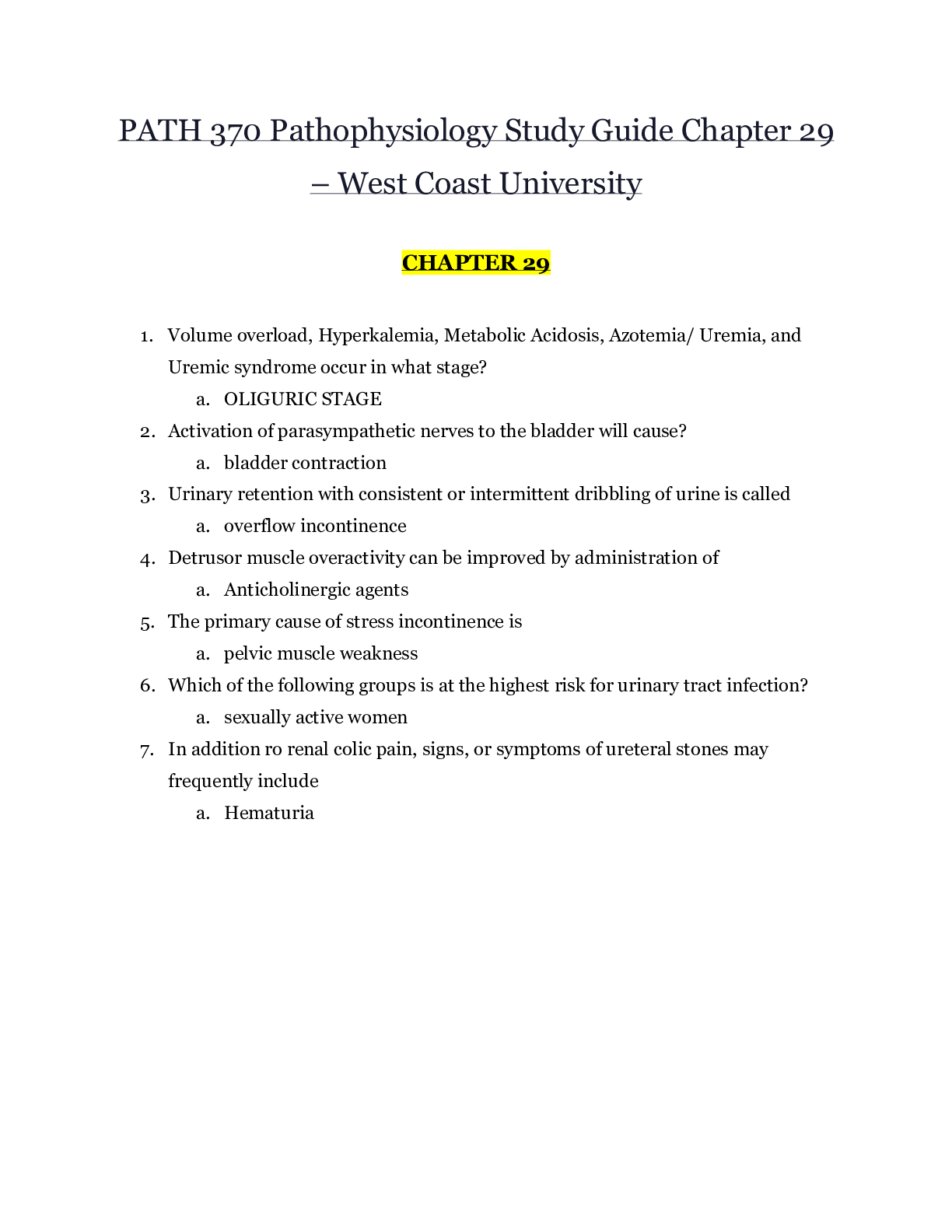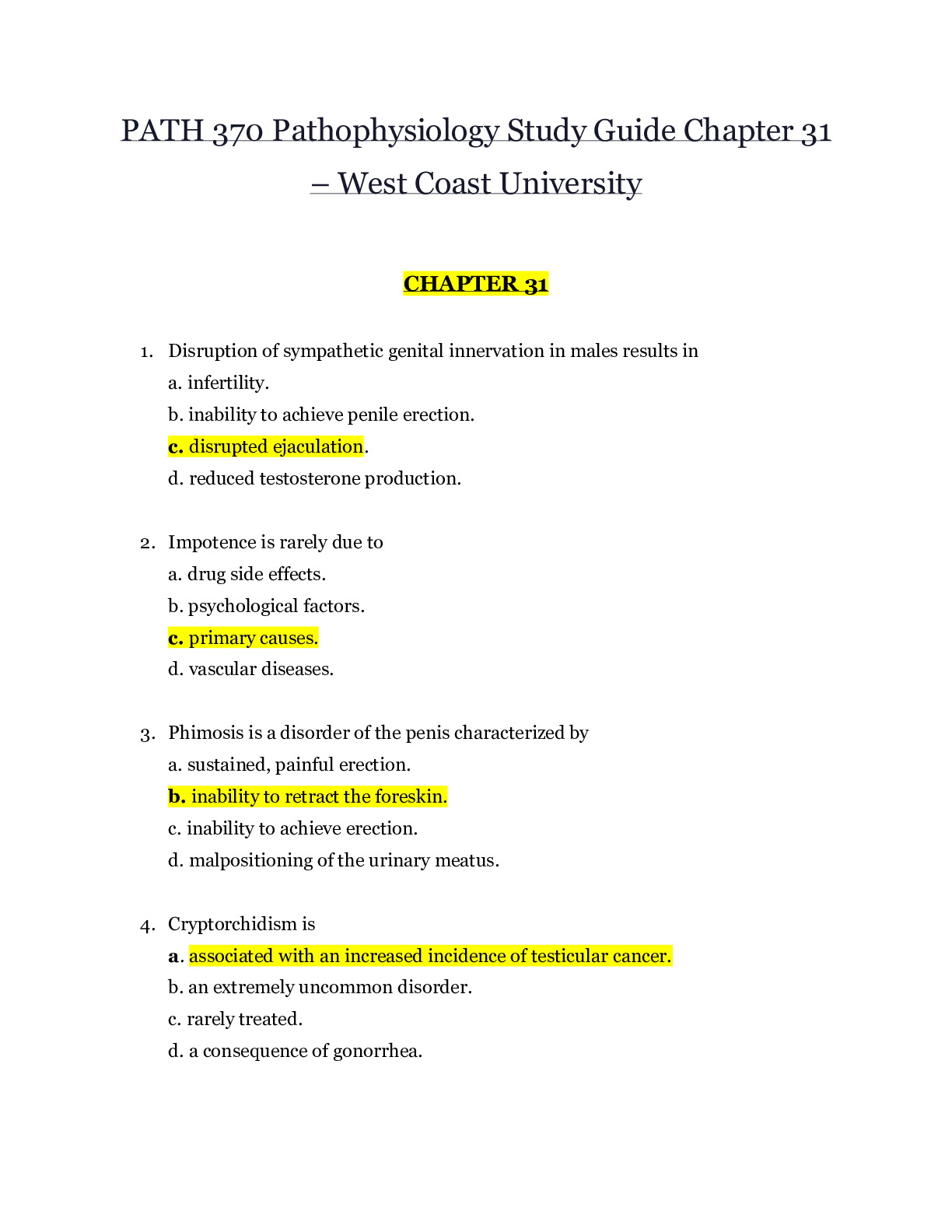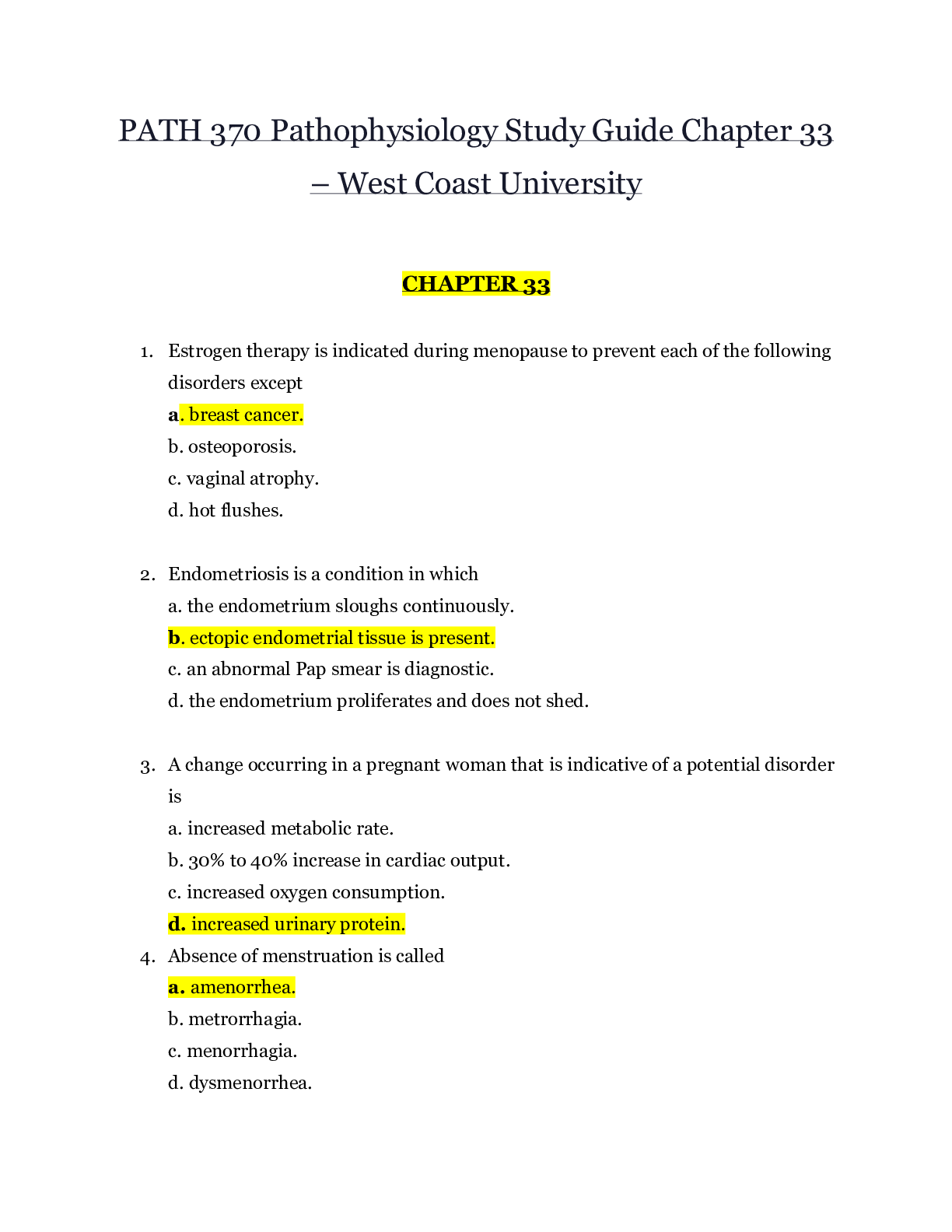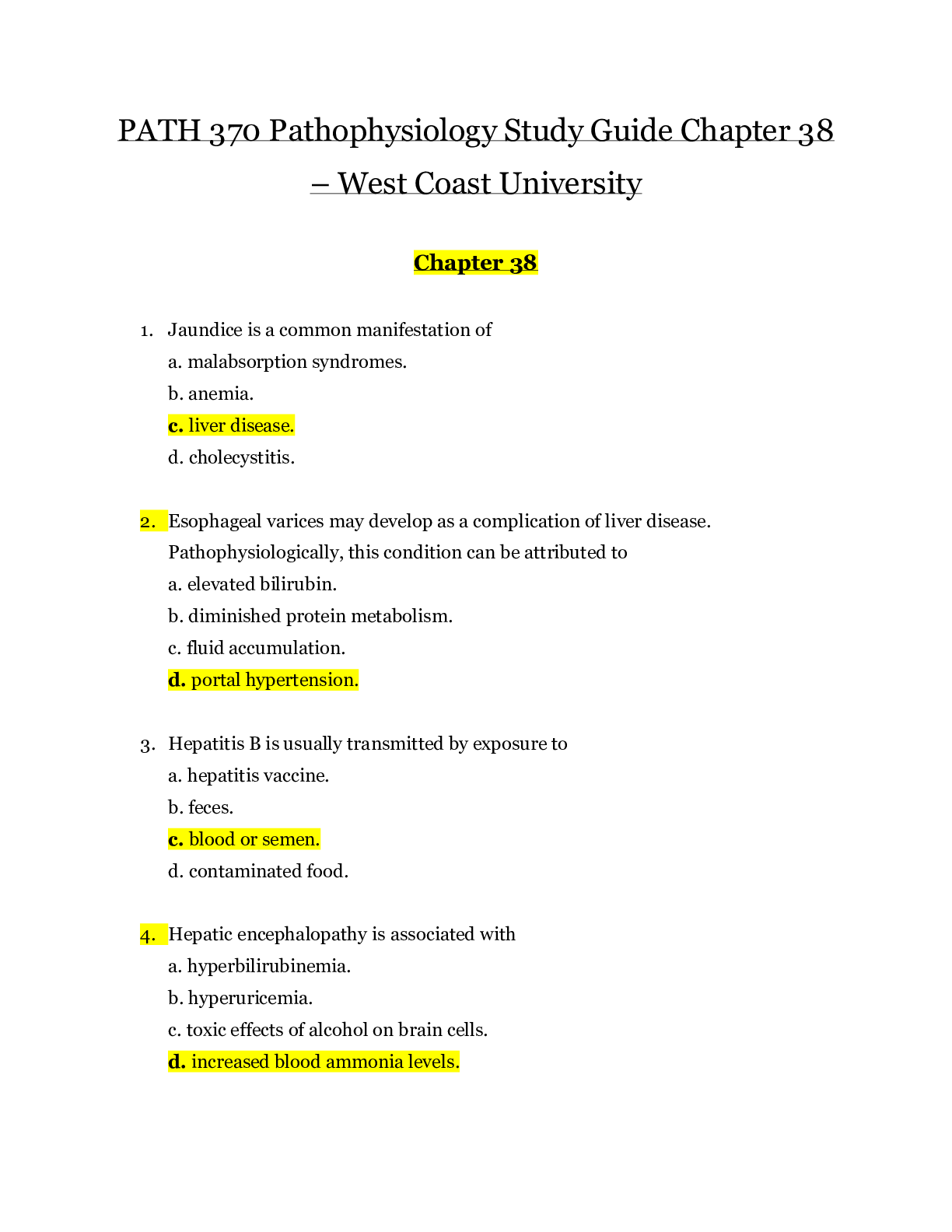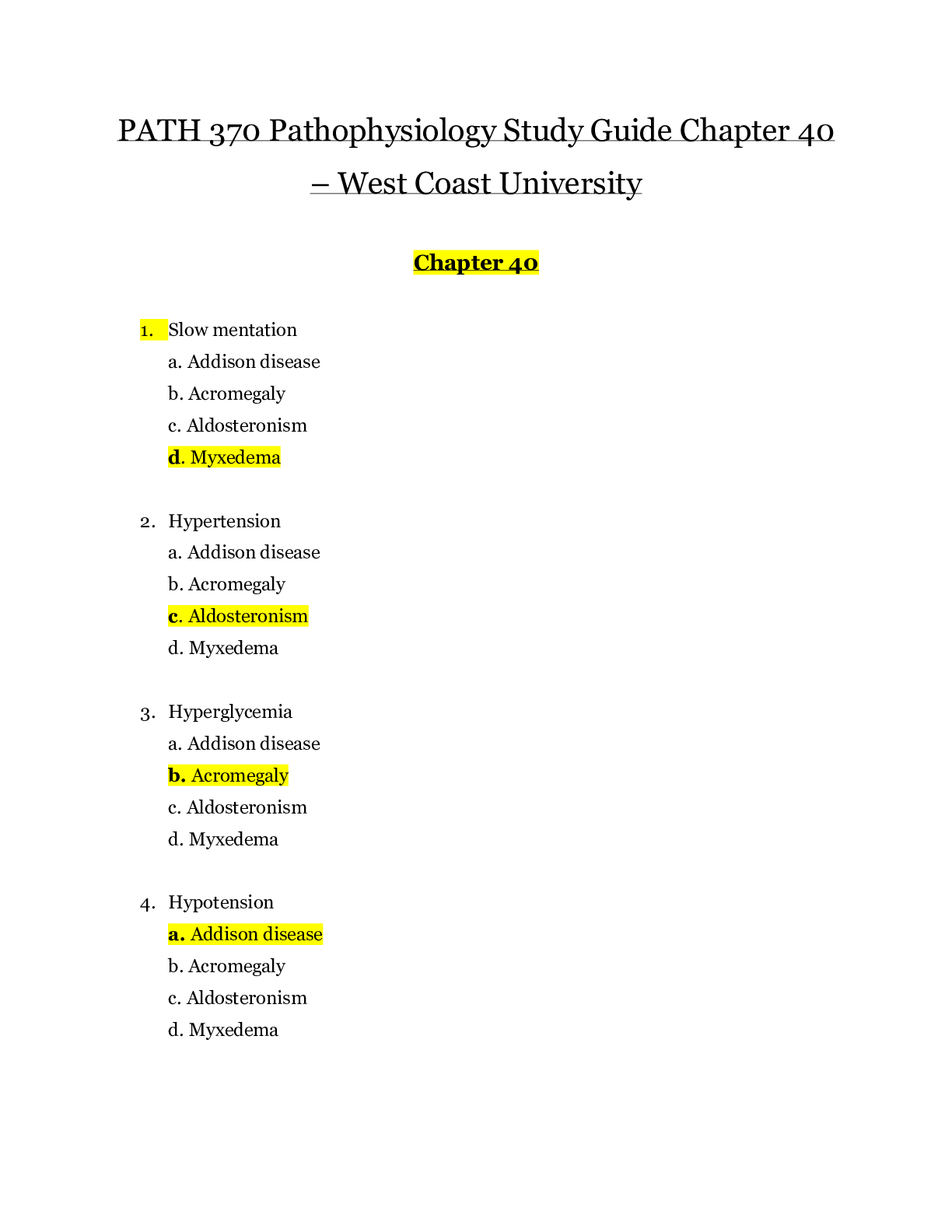Pathophysiology > EXAM > PATH 370 Pathophysiology Study Guide Chapter 36 – West Coast University | PATH370 Pathophysiology (All)
PATH 370 Pathophysiology Study Guide Chapter 36 – West Coast University | PATH370 Pathophysiology Study Guide Chapter 36
Document Content and Description Below
PATH 370 Pathophysiology Study Guide Chapter 36 – West Coast University Chapter 36 1. Which of the following symptoms suggests the presence of a hiatal hernia? a. Nausea b. Heartburn c. ... Diarrhea d. Abdominal cramps 2. Histamine antagonists may be used in the management of peptic ulcer disease to a. increase gastric motility. b. inhibit secretion of pepsinogen. c. neutralize gastric acid. d. decrease hydrochloric acid (HCl) secretion. 3. Epigastric pain that is relieved by food is suggestive of a. pancreatitis. b. cardiac angina. c. gastric ulcer. d. dysphagia. 4. The most common cause of mechanical bowel obstruction is a. volvulus. b. intussusception. c. adhesions. d. fecal impaction. 5. Acute right lower quadrant pain associated with rebound tenderness and systemic signs of inflammation are indicative of a. appendicitis. b. peritonitis. c. cholecystitis. d. gastritis. 6. A silent abdomen 3 hours after bowel surgery most likely indicates a. peritonitis. b. mechanical bowel obstruction. c. perforated bowel. d. functional bowel obstruction. 7. Ulcerative colitis is commonly associated with a. bloody diarrhea. b. malabsorption of nutrients. c. fistula formation between loops of bowel. d. inflammation and scarring of the submucosal layer of the bowel. 8. An early indicator of colon cancer is a. rectal pain. b. bloody diarrhea. c. a change in bowel habits. d. jaundice. 9. A patient who should be routinely evaluated for peptic ulcer disease is one who is a. taking 6 to 8 tablets of acetaminophen per day. b. being treated with high-dose oral glucocorticoids. c. experiencing work-related stress. d. routinely drinking alcoholic beverages. 10. Celiac sprue is a malabsorptive disorder associated with a. inflammatory reaction to gluten-containing foods. b. megacolon at regions of autonomic denervation. c. ulceration of the distal colon and rectum. d. deficient production of pancreatic enzymes. 11. Which of the following clinical findings would suggest an esophageal rather than an oropharyngeal cause of dysphagia? a. Nasal regurgitation b. Airway obstruction with swallowing c. Chest pain during meals d. Coughing when swallowing 12. Combined dysphagia with both solids and liquids is typical of a. esophageal stricture. b. achalasia. (Because it is the second type of dysphagia) c. esophageal tumors. d. Mallory-Weiss syndrome. 13. In which of the following cases would it be inappropriate to manage dyspepsia with an empiric trial of an H2 blocker? a. Concomitant dysphagia b. sic use of nonsteroidal antiinflammatory drugs c. Dyspepsia occurring after meals d. Dyspepsia relieved by meals 14. A Barrett esophagus is a. best managed with H2 antagonists. b. a preneoplastic lesion. c. a benign condition. d. a gastrin-secreting tumor. 15. Which of the following findings should prompt further diagnostic testing in a child presenting with diarrhea? a. Periumbilical discomfort b. Greenish, watery diarrhea c. Frequent, large-volume diarrhea d. Blood and mucus in the stools 16. Fecal leukocyte screening would be indicated in a patient with suspected a. lactose intolerance. b. inflammatory bowel disease. c. laxative abuse. d. giardiasis. 17. Which of the following findings would rule out a diagnosis of irritable bowel syndrome in a patient with chronic diarrhea? a. Negative stool leukocytes b. Intermittent constipation c. Abdominal pain and distention d. Bloody stools 18. An urgent surgical consult is indicated for the patient with acute abdominal pain and a. vomiting. b. CVA tenderness. c. absent bowel tones. d. borborygmi. 19. Painful swallowing: a. Dysphagia b. Achalasia c. Odynophagia d. Diverticulosis e. Encopresis 20. Difficulty swallowing: a. Dysphagia b. Achalasia c. Odynophagia d. Diverticulosis e. Encopresis 21. Herniations in the bowel wall: a. Dysphagia b. Achalasia c. Odynophagia d. Diverticulosis e. Encopresis 22. Absence of peristalsis in a portion of the esophagus: a. Dysphagia b. Achalasia c. Odynophagia d. Diverticulosis e. Encopresis 23. Stasis and involuntary leakage of stool: a. Dysphagia b. Achalasia c. Odynophagia d. Diverticulosis e. Encopresis [Show More]
Last updated: 2 years ago
Preview 1 out of 5 pages
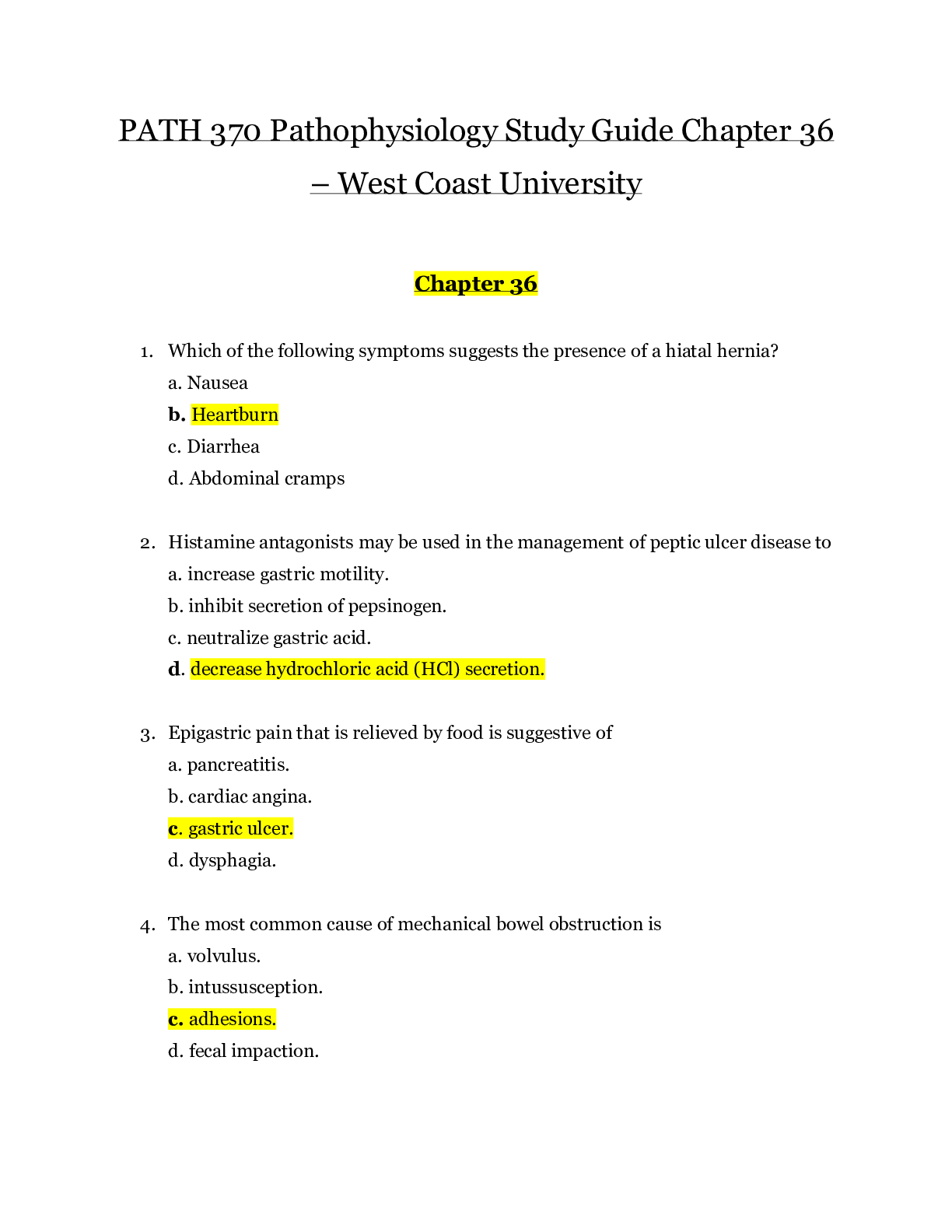
Buy this document to get the full access instantly
Instant Download Access after purchase
Buy NowInstant download
We Accept:

Reviews( 0 )
$8.50
Can't find what you want? Try our AI powered Search
Document information
Connected school, study & course
About the document
Uploaded On
Jul 28, 2020
Number of pages
5
Written in
Additional information
This document has been written for:
Uploaded
Jul 28, 2020
Downloads
0
Views
92








 – University of the People.png)
